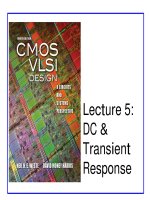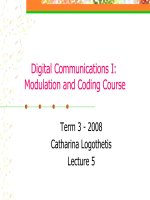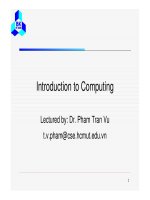Lecture Electrical Engineering: Lecture 5 - Dr. Nasim Zafar
Bạn đang xem bản rút gọn của tài liệu. Xem và tải ngay bản đầy đủ của tài liệu tại đây (590.13 KB, 19 trang )
COMSATS Institute of Information Technology
Virtual campus
Islamabad
Dr. Nasim Zafar
Electronics 1
EEE 231 – BS Electrical Engineering
Fall Semester – 2012
Carrier Transport in Semiconductors
Lecture No: 5
Diffusion of Carriers
v
v
Diffusion Processes
Diffusion and Recombination
v
v
Continuity Equations
v
Einstein Relation
Kwangwoon
University
Nasim Zafar
Semiconductor device lab.
Semiconductor Devices.
Carrier Diffusion:
Introduction:
Ø
When excess carriers are created nonuniformly in a semiconductor,
a “concentration gradient” results due to this nonuniformity of the carrier
densities in the sample. This concentration gradient, for electrons and holes, will
cause a net motion of the charge carriers from the regions of high density to the
regions of low carrier density. This type of carrier motion is called Diffusion and
represents an important charge transport process in semiconductors.
Ø
Thus, the charge carriers in a semiconductor diffuse, due to the concentration
gradient by random thermal motion and under going scattering from:
Ø
The lattice vibrations and
Ø
Ionized Impurity atoms.
Carrier Diffusion:
Introduction:
v When excess
Carrier Diffusion:
Introduction:
v Thus, the charge carriers in a semiconductor diffuse, due to
the concentration gradient by random thermal motion and
under going scattering from:
vThe lattice vibrations and
vIonized Impurity atoms.
Carrier Diffusion:
How can we produce a concentration gradient in a semiconductor?
Ø
By making a semiconductor or metal contact.
Ø.
By illuminating a portion of the semiconductor with light, (next slide).
As the carriers diffuse, a diffusion current flows. The force behind the
diffusion current is due to the random thermal motion of the carriers.
dn
1 dP
Ø.
dx
=
kT
dx
Photo Generation and Diffusion:
Current mechanisms
Drift Current
Diffusion Current
photons
P = nkT
dP dn
=
kT
dx dx
dn 1 dP
=
dx kT dx
Contact with a metal
Photo Generation and Diffusion:
Ø By shining light, electronhole pairs can be produced when the photon
energy>Eg.
Ø The increased number of electronhole pairs will move toward the lower
concentration region, until they reach their equilibrium values.
Ø So there is a net number of the charge carriers crossing per unit area per
unit time, which is called flux.
Ø Units: [Flux] = m2 – S1
Diffusion Flux :
Fick’s first law
Diffusion Flux ∞ Concentration Gradient dn/dx
dn
Flux = − Dn
dx
[Flux] = m2 – S1
v
v
D = vth l , [ D] = m2/S
D measures the ease of carrier diffusion in
response to a concentration gradient.
D limited by vibrations of lattice atoms and
ionized dopant impurities.
Diffusion Flux :
v For Electrons:
Fn = Dn dn/dx
v For Holes:
Fp = Dp dp/dx
Dn = electron diffusion coefficient
Dp = hole diffusion coefficient
Einstein Relationship:
Ø Einstein relation relates the two independent current mechanicms of
mobility µ with diffusion D.
µn = qτn/mn*
Dn = kTτn/mn*
½ m*v2 = ½ kT
Dn = v2τn = l2/τn
Einstein Relation:
Dn kT
=
µn
q
and
Dp
kT
=
µp
q
for electrons and holes
Constant value at a fixed temperature
2
cm sec
= volt
2
cm V − sec
kT
= 25 mV
q
kT ( J / K ) ( K )
=
= volt
q
C
at room temperature
Diffusion Current Density: J
Diffusion current density = charge x carrier flux
Total Current:
Ø Diffusion Current within a semiconductor consists of:
i.
hole component and
ii.
electron component
Ø Total Current flowing in a semiconductor is the sum of:
i.
drift current and
ii.
diffusion current:
Diffusion Current Densities:
[ Flux ] = m−2 − s −1
D = ν thl , [ D ] = m 2
s
The current densities for electrons and holes
dn
� dn �
J n = −q �
− Dn �= qDn
dx
� dx �
for electrons
dp
� dp �
J p = +q �
− Dp
=
−
qD
p
�
dx
dx
�
�
for holes
2
�
�
�
�
J
=
A
m
�n , p � �
�
Total Current Density:
When both electric field and the concentration gradient are
present, the total current density, for the electron, is given as:
dn
J n = qµ n nE + qDn
dx
dp
J p = q µ p pE − qD p
dx
J total = J n + J p
Summary
Ø
Current flowing in a semiconductor consists of drift and
diffusion components:
J tot
qp
qn n E qDn
pE
dn
dp
qD p
dx
dx
Ø
Mobility and Conductivity are highly temperature dependent.
Ø
Generation and Recombination processes were discussed.
Nasim Zafar
18
Summary
1
Resistivity formula
qp p qn n
J drift
J n | diff
Jp
Jn
J n | drift
J p |drift
q
dn
qDn
and J p | diff
dx
J p|drift
J n |drift
J p|diff
J n |diff
nn
pp
Drift current density
E
dp
qDp
dx
qpE
( )qDp
qnE
dn
qDn
dx
dp
dx
Diffusion current density
Total hole and electron
current density
J = Jn + Jp Total current density
19









